What makes a hotel iconic? Is it a long history, a unique design, or that people regard it as a reflection of the city where it stands? Bart Leclercq, head of structures design for the architecture firm, WSP, argues that what makes a building iconic is its unique design, its symbolism and its history. Salim Hussain of Brewer Smith Brewer Gulf concurs that design is a key factor, but adds that an iconic building becomes a metaphor for people’s aspirations—a statement of intent. Others like Richard Fenne of Woods Baggot Middle East believe that an iconic status is something the public bestows on a building and that it cannot necessarily be designed. Perhaps Collins English Dictionary captures these perspectives with its simple definition of an icon as a “thing regarded as a symbol of a belief, nation, community, or cultural movement.” Here we take a closer look at some famous hotels that have become iconic.
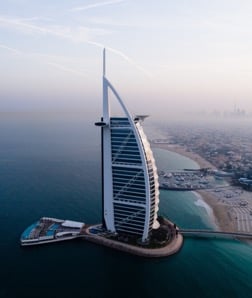
The Burj Al Arab Hotel in Dubai
Image via Unsplash
Waldorf-Astoria, New York City
Undoubtedly, one of the most iconic hotels in the world is the Waldorf-Astoria in New York City. The hotel’s roots are in a family feud between rival cousins, William Waldorf Astor, and John Jacob Astor (“J.J.”). William, presumably to irritate his cousin, built a 13-story hotel named the Waldorf in 1893 on the corner of 33rd Street and 5th Avenue, a residential neighborhood where J.J.’s mother lived. He hired renowned architect, Henry Hardenbergh, to design and manage the construction. The hotel’s 450 rooms offered private bathrooms, electricity and room service, and was the first hotel to offer a kid’s menu. The exterior style was German Renaissance and the interior furnishings included many European antiques.
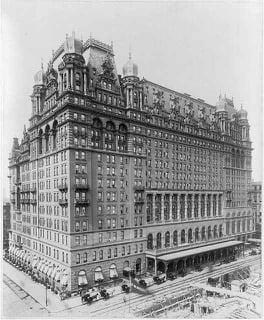
The Original Waldorf-Astoria
Four years later, and not to be out-done by his cousin, J.J., who owned the other half of the block, built the 17-story Astor a few feet away. He used the same architect as William. He even persuaded George Boldt, whom William hired to manage the Waldorf, to run his hotel, too. In fact, Boldt was responsible for the naming of the hotel although J.J. favored calling it The Schermerhon (his mother’s maiden name). Boldt thought it was too complicated, and would only consent to manage the hotel if the moniker was simpler. Like its neighbor the Hotel Astor’s style was German Renaissance, but the ballroom, touted as the "pièce de résistance,” was in Louis XIV style.
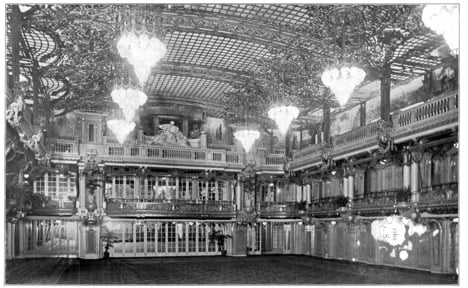 Southern end of the Grand Ballroom, Hotel Astor
Southern end of the Grand Ballroom, Hotel Astor
Image via Wikimedia Commons
In time, the feuding cousins allowed good business judgment to prevail, and the hotels were connected by a 300-foot hallway known as Peacock Alley for the Gilded Age aristocrats who regularly walked the path. The merger made Waldorf-Astoria the largest hotel in the world. Ironically, fate intervened in the family feud. J.J. divorced his first wife and married 18-year-old socialite, Madeline Force. To avoid the controversy of this “May-December romance,” the couple took an extended honeymoon in Europe and the Middle East. They boarded the Titanic in April of 1912 for their return. Madeline and their unborn son survived the sinking, but J.J. did not.
By the 1920s, the Victorian-era Waldorf-Astoria was outdated. Prohibition impacted business by putting a damper on the hotel’s nightlife. In 1928, developers bought the property and demolished the structure in 1929 to make way for the Empire State Building.
The current hotel opened in 1931 on Park Avenue between 48th and 49th Streets with 2,200 rooms and 47 stories. The notable history since 1931 includes many fascinating accounts. Two presidents took up residence there. President Herbert Hoover delivered an address from the hotel in 1933 and moved in after leaving office. He passed away in his suite in 1964. Dwight Eisenhower lived in the Waldorf from 1967 until his death in 1969. His rooms became the Presidential Suite, and every sitting president since then has occupied the space. The suite includes Douglas MacArthur’s personal desk and a rocking chair belonging to John F. Kennedy. Track 61 connected the hotel to Grand Central Terminal, allowing VIPs like Franklin D. Roosevelt access via private rail car. Culinary creations credited to the hotels’ restaurants include the Waldorf salad, veal Oscar, eggs benedict, and Thousand Island dressing.
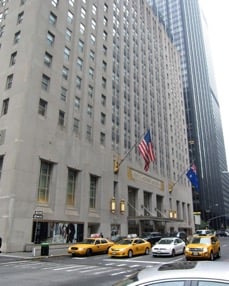
The Waldorf-Astoria Today
Alan Light [CC BY 2.0 (https://creativecommons.org/licenses/by/2.0)], via Wikimedia Commons)
Surely because of its popularity and reputation, guests have pilfered many items from the hotel over the decades. In an attempt to recover some of these items, the hotel announced an amnesty program in 2012 to allow people to return items without penalty. Items people returned included pink teapots, silverware, ashtrays, serving trays, frying pans, and even a 51-piece cutlery set.
Classically Art Deco, the current Waldorf-Astoria had some renovation work throughout the years, but nothing compared to the current remodel. The Hotel closed in 2017 for a three-year renovation by Chinese owner, Anbang. Plans call for converting the Waldorf into a hotel and condo and creating approximately 350 luxury condominiums and 350 new hotel rooms..
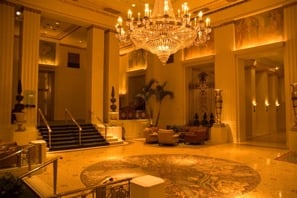 The Waldorf-Astoria Lobby
The Waldorf-Astoria Lobby
Image via Flickr by Ashley Ringrose licensed under CC BY-NC-ND 2.0
Grosvenor House Hotel, London
Opening in 1929 with 472 rooms on the residence of former Dukes of Westminster, this hotel bears the name of one original property owner from the 1600s. Mary Davies inherited two-thirds of her wealthy father’s lands when he died in the Great Plague of 1665. At the time, the land consisted of meadows and swamps. An aunt brought up the heiress until she married nobleman, Sir Thomas Grosvenor, on October 10, 1677. The property was a dowry for Grosvenor from his new wife. Robert Grosvenor, the First Marquess of Westminster purchased the property in 1805 for 20,000 pounds. In the ensuing years, the family expanded the residence significantly to include a classical-style entrance with a colonnade. At each end was a triumphal arch with pediments above sculpted with the Grosvenor family coat of arms. The property remained in family hands until World War I when the government requisitioned it. After the war, the family sold it, thinking it too lavish. The structure was demolished to make way for the hotel.
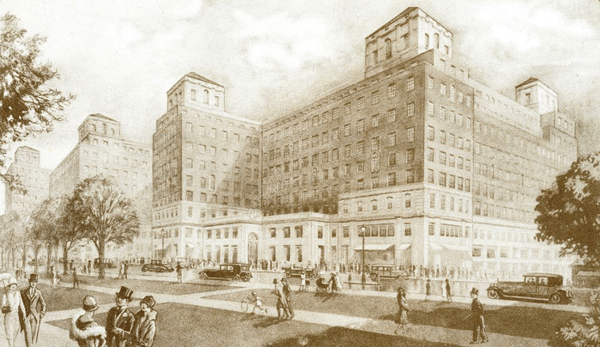
Grosvenor House Colonnade Circa 1842
Image via Wikimedia Commons
The Great Gatsby-esque Art Deco interior features high mirrors, gold trimmings, and marble floors. It was London’s first hotel with running ice water in every room and private baths. The historic Great Room opened in 1934 and was London’s first banquet room. Originally this space was an ice rink where Queen Elizabeth II took skating lessons.
During World War II, the Great Room housed an officer’s club and a mess hall that served 5.5 million meals to U.S. military personnel in two years. The Beatles performed in the hotel in the 1960s. Other celebrity guests through the years have included Henry Kissinger, President Obama, Mike Tyson, and Leonardo DiCaprio.
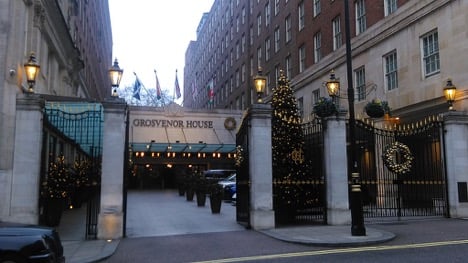
The Grosvenor
Attribution: Simeon87 [CC BY-SA 4.0 (https://creativecommons.org/licenses/by-sa/4.0)], from Wikimedia Commons
Hotel National, Moscow
Often described by Muscovites at the “quintessential Russian hotel,” Hotel National opened in 1903 in the heart of city near Red Square, the Kremlin, and Aleksandrovsky Garden. The exterior of the Art Nouveau edifice has stone and ceramic tile decorations, while the interior features marble stairs in the lobby, many stained windows, mosaic floors, and atlas figures. The room furnishings were custom made from redwood, light oak, and other exotic materials. The hotel was equipped with central heat and many of the rooms had private bathrooms and safes. For the convenience and comfort of guests, the National offered a reading hall, restaurant, shops, a bakery, and a wine cellar. Frequent guests were wealthy merchants, manufacturers, diplomats, actors, and artists.
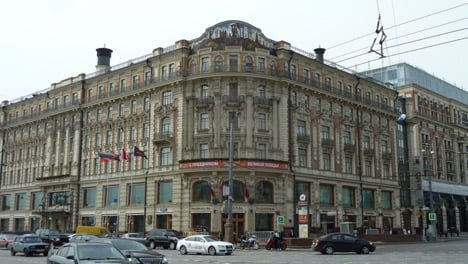 Hotel National
Hotel National
Image via Flickr by Maxim Off, licensed under CC BY-NC-ND 2.0
As one can imagine, the Hotel National is connected with significant events in modern Russian history. During the October Revolution in 1917, the National was a base for counter-revolutionaries. After the Bolshevik victory, members of the new government such as Dzerzhinsky, Sverdlov, Trotsky, Lenin, and Krupskaya stayed there. Readers interested in the sequence of events during the revolution, can check out this 1917 timeline. The National was home to the country’s Central Executive Committee for several years.
In the 1930s the government recommissioned the structure as a hotel with a major reconstruction. Workers tiled the ground floor in granite and furnishings for the common areas from the Anichkov and Grand Palaces and Great Palaces made the hotel look more like a museum. Unfortunately, the cost for accommodations was quite high even for foreigners, mostly because occupancy waned to the point that the National closed in 1985 for a complete renovation. Ten years later, the National reopened and began a new era in its history. It quickly became popular and was awarded a 5-star rating. Despite a tragic act of terrorism on December 9, 2003, when a car exploded near the hotel entrance. Six people died including the suicide bombers, and 12 were wounded. Yet, the National remains one of the best hotels in Moscow.
Burj Al Arab, Dubai
Built on a private, man-made island, the Burj Al Arab (translated as “The Arabian Tower”) is a favorite photo backdrop for tourists and locals alike. Tom Wright, the principal architect, commenced construction in 1999. The five-year-long project involved an international team of over 3,000 contractors, 250 designers, and 3,500 workmen onsite at any given time. The building sits on a private island 15 kilometers from one of the oldest neighborhoods in Dubai, Jumeirah. The 321-meter (1,053 feet) Burj is one of the tallest hotels on Dubai’s coast and the fourth tallest hotel in the world. Guests in its 202, two-story rooms see the city from a unique coastal view and enjoy some of the world’s finest and most expensive interiors.
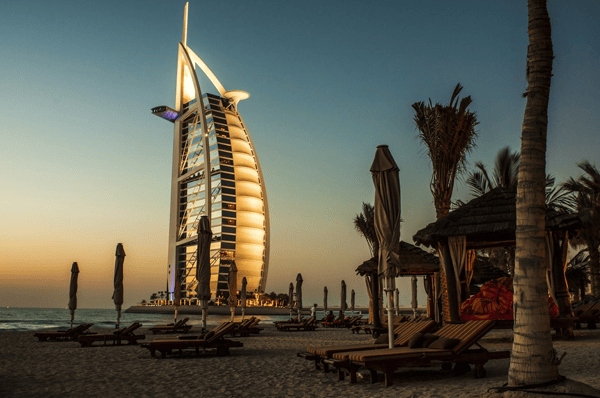
580-Foot Tall Atrium
Image via Pixabay
The hotel required complex engineering. To secure a foundation on the private island where it rests, builders drove 230, 130-foot-long concrete piles into the sand. The foundation was built upon a surface layer of large rocks encased in a concrete honeycomb to protect it from erosion. It took workers three years to secure the sea-engulfed land, and another three years to construct the building. The structure contains over 92,000 cubic yards of concrete and 9,000 tons of steel.
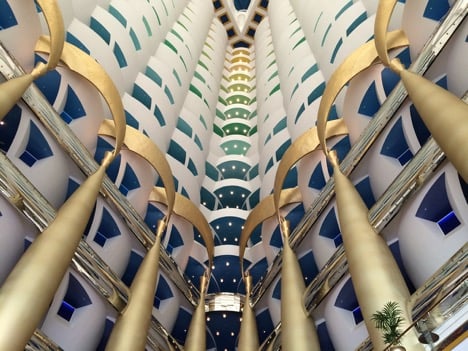
Image via Pixabay
Rooms at the Burj are in high demand and, speaking of “high,” so are the room rates. The rate ranges from about $2,000 per night to $24,000 per night for the 8,395-square-foot Royal Suite on the 25th floor (making the suite the 12th most expensive hotel room in the world). At these rates, many guests consider a stay here as an once-in-a-lifetime experience. The Royal Suite includes a butler, two bedrooms, three bathrooms, a library, lounge, cinema, and private entrance.
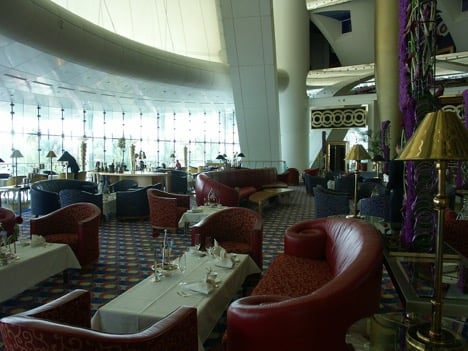
Burj Al Arab Lounge
Image via Pixabay
The hotel also offers Rolls Royce chauffeur service, a helipad, an exotic aquarium staffed by a team of marine biologists to look after the fish and sharks, and nine restaurants that cater to each guest’s desires, as part of its proclaimed status as the world’s only seven-star hotel. Though there is no official seven-star rating in the industry, the origin of this “rating” is unknown, even the management claims not to ascribed seven stars to the hotel.
These are but a few examples of iconic hotels around the world. Each has had a unique journey to stardom, and for some, the status came sooner than others.
References
Baftrikosa, E. (2017). The history of the Burj Al Arab in 1 minute. Retrieved December 15, 2018, from https://theculturetrip.com/middle-east/united-arab-emirates/articles/the-history-of-the-burj-al-arab-in-1-minute/
Burke, K. & Greene, L. (2017). New York’s Waldorf Astoria hotel closes for major renovations. Retrieved December 15, 2018, from www.nydailynews.com/new-york/new-york-waldorf-astoria-hotel-closes-major-renovations-article-1.2983845
Economic Times. (2016). History sheet of Grosvenor House: The famous London hotel that Sahara Group\p has reportedly sold to the state of Qatar. Retrieved December 14, 2018, from https://economictimes.indiatimes.com/magazines/panache/history-sheet-of-grosvenor-house-the-famous-london-hotel-that-sahara-group-has-reportedly-sold-to-the-state-of-qatar/articleshow/51120737.cms
Farlex. (2018). Icon. Retrieved December 14, 2018, from www.thefreedictionary.com/icon
Klein, C. (n.d.). Iconic Waldorf Astoria hotel changes hands. Retrieved December 14, 2018, from www.history.com/news/iconic-waldorf-astoria-hotel-changes-hands
Leader-Courier & Times. (2018). Iconic hotels in Europe. Retrieved December 14, 2018, from www.leadercourier-times.com/online_features/travel/article_07d6baf6-eaea-5ce6-a79b-cf866d840ee1.html
Schneider, K. (2013). Inside the $24,000 a night royal suite at the Burj Al Arab, Dubai. Retrieved December 15, 2018, from www.news.com.au/travel/travel-ideas/inside-the-24000-a-night-royal-suite-at-the-burj-al-arab-dubai/news-story/1151dd79cbf99174d172e35e43e81534
Optima Tours. (2012). National Hotel. Retrieved December 15, 2018, from http://www.moscow-hotels.com/national.htm
Schatzle, R. (2015). Inside Dubai’s exclusive $20,000-a-night ‘seven-star’ hotel. Retrieved December 15, 2018, from https://nextshark.com/burj-al-arab-hotel-dubai/
Tomlinson, A. (2014). Constructing great reputations: What makes a building iconic? Retrieved December 14, 2018, from www.thenational.ae/arts-culture/constructing-great-reputations-what-makes-a-building-iconic-1.235562
Untapped Cities. (2018). Top 15 secrets of the Waldorf-Astoria hotel in NYC. Retrieved December 14, 2018, from https://untappedcities.com/2015/07/13/top-15-secrets-of-the-waldorf-astoria-hotel-in-nyc/
Weigand, E. 10 culturally significant hotels in Moscow. Retrieved December 15, 2018, from https://theculturetrip.com/europe/russia/articles/from-pre-revolution-architecture-to-boutique-luxury-ten-culturally-significant-hotels-in-moscow/
Wikipedia. (2018). Burj Al Arab. Retrieved December 15, 2018, from https://en.wikipedia.org/wiki/Burj_Al_Arab
Wikipedia. (2018). Grosvenor House. Retrieved December 15, 2018, from https://en.wikipedia.org/wiki/Grosvenor_House
Wikipedia. (2018). Waldorf-Astoria (1893-1929). Retrieved December 14, 2018, from https://en.wikipedia.org/wiki/Waldorf–Astoria_(1893–1929)






